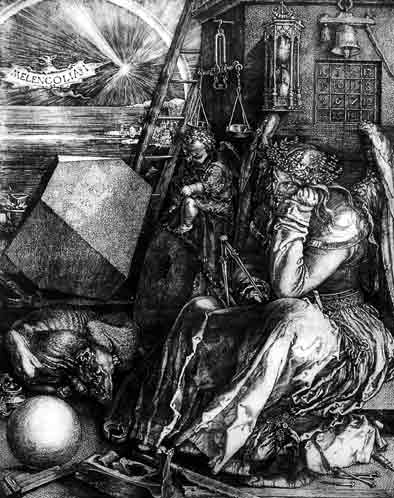
|
|
|
Dürer's solid, also known as the truncated triangular trapezohedron, is the 8-faced solid depicted in an engraving entitled Melencolia I by Albrecht Dürer
(The British Museum, Burton 1989, Gellert et al. 1989), the same engraving
in which Dürer's magic square appears,
which depicts a disorganized jumble of scientific equipment lying unused while an
intellectual sits absorbed in thought. Although Dürer does not specify how his
solid is constructed, Schreiber (1999) has noted that it appears to consist of a
distorted cube which is first stretched to give rhombic
faces with angles of ,
and then truncated on top and bottom to yield bounding triangular faces whose vertices
lie on the circumsphere of the azimuthal cube vertices.
It is implemented in the Wolfram Language as PolyhedronData["DuererSolid"].
The skeleton of Dürer's solid is the Dürer graph (i.e., generalized Petersen graph ).
Starting with a unit cube oriented parallel to the axes of the coordinate system, rotate it by Euler angles and
to align a threefold symmetry axis along
the
-axis. The stretch factor needed to produce
rhombic angles of
is then
 |
(1)
|
The azimuthal points are a distance away from the origin, and in order for the vertices of
the triangles obtained by truncation to lie at this same distance, the truncation
must be done a distance
along the edge from one of the azimuthal points, which corresponds to a height
 |
(2)
|
The resulting solid has six pentagonal faces and two equilateral
triangular faces, and the lengths of the sides are in the ratio
|
(3)
|
Examination of this solid shows it to be identical to the dimensions of the solid reconstructed from its perspective picture (Schröder 1980, p. 70; Schreiber 1999).
The canonical polyhedron of Dürer's solid is a cube truncated at two opposite corners leaving two equilateral trianglular
faces whose edges are
times the length of the full cube edges (E. Weisstein, Apr. 19, 2022).
This solid is implemented in the Wolfram
Language as PolyhedronData["DuererCanonicalSolid"].